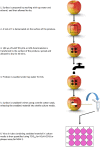Efficacy of washing produce in removing human coronavirus OC43 and murine norovirus
- PMID: 35702940
- PMCID: PMC9545982
- DOI: 10.1111/jam.15667
Efficacy of washing produce in removing human coronavirus OC43 and murine norovirus
Abstract
Aims: Fresh produce is often a vehicle for the transmission of foodborne pathogens such as human norovirus. Thus, it is recommended to wash the surface of produce before consumption, and one of the most common ways to wash produce is by rinsing under running tap water. This study determined the effectiveness of removal of human coronavirus-OC43 (HCoV-OC43), as a surrogate for severe acute respiratory syndrome coronavirus-2 (SARS-CoV-2) and murine norovirus-1 (MNV-1), as a surrogate for human norovirus, from contaminated lettuce, apples and cucumbers.
Methods and results: The produce surfaces were artificially inoculated in conjunction with faecal material to represent natural contamination. Rinsing under tap water for 10 s at 40 ml/s removed 1.94 ± 0.44, 1.42 ± 0.00 and 1.42 ± 0.42 log of HCoV-OC43 from apple, cucumber and lettuce respectively. The same washing technique removed 1.77 ± 0.17, 1.42 ± 0.07 and 1.79 ± 0.14 log of MNV-1 from apple, cucumber and lettuce respectively. This washing technique was effective at reducing a significant amount of viral contamination, however, it was not enough to eliminate the entire contamination. There was no significant difference in the reduction of viral load between the two viruses, nor between the three surfaces tested in this study.
Conclusions: Our data suggest that washing under tap water would be an efficient way of reducing the risk of foodborne viral transmission only if the level of contamination is less than 2 log PFU.
Significance and impact of study: This study demonstrates that running tap water was effective at reducing the amount of infectious HCoV-OC43 and MNV on produce surfaces, and washing produce continues to be an important task to perform prior to consumption to avoid infection by foodborne viruses, particularly for foods which are eaten raw.
Keywords: human coronavirus OC43; murine norovirus-1; produce; tap water; wash.
© 2022 Her Majesty the Queen in Right of Canada. Journal of Applied Microbiology published by John Wiley & Sons Ltd on behalf of Society for Applied Microbiology. Reproduced with the permission of the Minister of Health.
Conflict of interest statement
None to be declared.
Figures



Similar articles
-
Norovirus cross-contamination during preparation of fresh produce.Int J Food Microbiol. 2015 Apr 2;198:43-9. doi: 10.1016/j.ijfoodmicro.2014.12.023. Epub 2014 Dec 27. Int J Food Microbiol. 2015. PMID: 25590260
-
Efficacy of sodium hypochlorite and peroxyacetic acid to reduce murine norovirus 1, B40-8, Listeria monocytogenes, and Escherichia coli O157:H7 on shredded iceberg lettuce and in residual wash water.J Food Prot. 2009 May;72(5):1047-54. doi: 10.4315/0362-028x-72.5.1047. J Food Prot. 2009. PMID: 19517733
-
Effect of wash treatments on reducing human norovirus on iceberg lettuce and perilla leaf.J Food Prot. 2011 Nov;74(11):1908-11. doi: 10.4315/0362-028X.JFP-11-063. J Food Prot. 2011. PMID: 22054192
-
Comparison of chlorine and peroxyacetic-based disinfectant to inactivate Feline calicivirus, Murine norovirus and Hepatitis A virus on lettuce.Int J Food Microbiol. 2011 Nov 15;151(1):98-104. doi: 10.1016/j.ijfoodmicro.2011.08.011. Epub 2011 Aug 22. Int J Food Microbiol. 2011. PMID: 21924791
-
Human Coronavirus OC43 as a Low-Risk Model to Study COVID-19.Viruses. 2023 Feb 20;15(2):578. doi: 10.3390/v15020578. Viruses. 2023. PMID: 36851792 Free PMC article. Review.
Cited by
-
Content Analysis of Food Safety Information in Apple-Drying Recipes from YouTube, Blogs, Cookbooks, and Extension Materials.Foods. 2024 Mar 1;13(5):778. doi: 10.3390/foods13050778. Foods. 2024. PMID: 38472891 Free PMC article.
References
-
- Bae, J.Y. , Lee, J.S. , Shin, M.H. , Lee, S.H. & Hwang, I.G. (2011) Effect of wash treatments on reducing human norovirus on iceberg lettuce and perilla leaf. Journal of Food Protection, 74, 1908–1911. - PubMed
MeSH terms
Substances
Grants and funding
LinkOut - more resources
Full Text Sources
Medical
Research Materials
Miscellaneous

